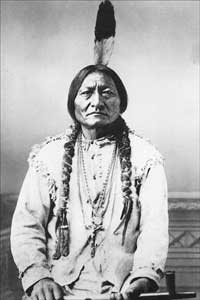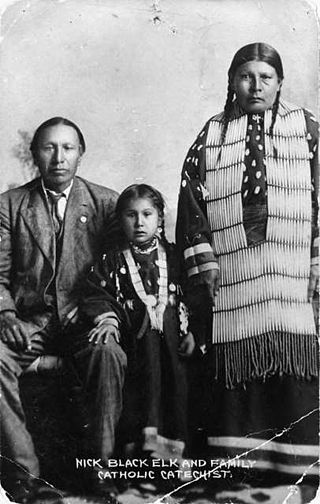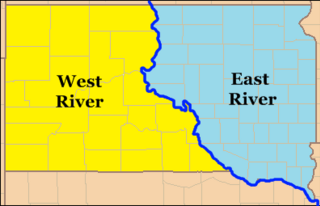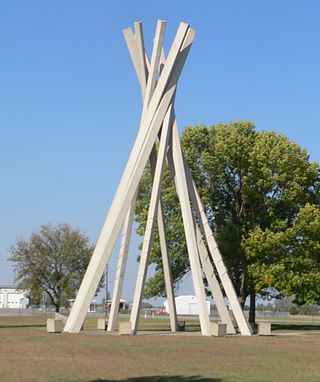
The Lakota are a Native American people. Also known as the Teton Sioux, they are one of the three prominent subcultures of the Sioux people, with the Eastern Dakota (Santee) and Western Dakota (Wičhíyena). Their current lands are in North and South Dakota. They speak Lakȟótiyapi—the Lakota language, the westernmost of three closely related languages that belong to the Siouan language family.

Chamberlain is a city in Brule County, South Dakota, United States. It is located on the east bank of the Missouri River, at the dammed section of the Lake Francis Case, close to where it is crossed by Interstate 90.

The Mount Rushmore National Memorial is a national memorial centered on a colossal sculpture carved into the granite face of Mount Rushmore in the Black Hills near Keystone, South Dakota, United States. The sculptor, Gutzon Borglum, named it the Shrine of Democracy, and oversaw the execution from 1927 to 1941 with the help of his son, Lincoln Borglum. The sculpture features the 60-foot-tall (18 m) heads of four United States presidents: George Washington, Thomas Jefferson, Theodore Roosevelt, and Abraham Lincoln, chosen to represent the nation's birth, growth, development, and preservation. Mount Rushmore attracts more than two million visitors annually to the memorial park which covers 1,278 acres. The mountain's elevation is 5,725 feet (1,745 m) above sea level.

Heȟáka Sápa [h xaka,sapa] commonly known as Black Elk, was a wičháša wakȟáŋ and heyoka of the Oglala Lakota people. He was a second cousin of the war leader Crazy Horse and fought with him in the Battle of Little Bighorn. He survived the Wounded Knee Massacre in 1890. He toured and performed in Europe as part of Buffalo Bill's Wild West.

The Crow Creek Indian Reservation, home to Crow Creek Sioux Tribe is located in parts of Buffalo, Hughes, and Hyde counties on the east bank of the Missouri River in central South Dakota in the United States. It has a land area of 421.658 square miles (1,092.09 km2) and a 2000 census population of 2,225 persons. The major town and capital of the federally recognized Crow Creek Sioux Tribe is Fort Thompson.
Native American Day is a holiday observed in several US states in celebration of Native American culture. In California and Nevada, the holiday is designated on the fourth Friday of September, whereas in South Dakota and Wisconsin, it falls on the second Monday of October. Within each of these states, Native American Day honors the cultural contributions of Native American communities to the respective state's history, as well as to the overall country. The state of Washington celebrates Native American Heritage Day on the Friday immediately following the fourth Thursday in November. The state of Tennessee observes a similar American Indian Day each year on the fourth Monday of September. President George W. Bush signed into law legislation introduced by Congressman Joe Baca (D-Calif.), to designate the Friday after Thanksgiving as Native American Heritage Day.

West River is the portion of the state of South Dakota located west of the Missouri River; it contains more than one-half of the land area and between one-quarter and one-third of the population of the state.

Michael Spears is an Indigenous American actor. He is a member of the Kul Wičaša Lakota from the Lower Brulé Sioux Tribe of South Dakota.

The Crazy Horse Memorial is a mountain monument under construction on privately held land in the Black Hills, in Custer County, South Dakota, United States. It will depict the Oglala Lakota warrior Crazy Horse, riding a horse and pointing to his tribal land. The memorial was commissioned by Henry Standing Bear, a Lakota elder, to be sculpted by Korczak Ziolkowski. It is operated by the Crazy Horse Memorial Foundation, a nonprofit organization.
Compass is a public artwork by American artist Jon Barlow Hudson, located above the Brady Street Pedestrian Bridge, in Milwaukee, Wisconsin.
Beatrice Medicine was a scholar, anthropologist, and educator known for her work in the fields of Indigenous languages, cultures, and history. Medicine spent much of her life researching, teaching, and serving Native communities, primarily in the fields of bilingual education, addiction and recovery, mental health, tribal identity, and women's, children's, and LGBT community issues.
St. Joseph's Indian School is an American Indian boarding school, run by the Congregation of the Priests of the Sacred Heart just outside the city of Chamberlain, South Dakota, on the east side of the Missouri River. The school, located in the Roman Catholic Diocese of Sioux Falls and named after Saint Joseph, is operated by a religious institute of pontifical right that is independent of the diocese. The school is within two hours of three reservations of the Lakota people: the Cheyenne River Indian Reservation, the Lower Brule Indian Reservation and the Crow Creek Indian Reservation, whose children comprise the majority of students at the school. The Akta Lakota Museum and Cultural Center is located on the campus and is owned by the school.
Ruth Carolyn Ziolkowski was an American executive and CEO of the Crazy Horse Memorial, a South Dakota monument dedicated to Crazy Horse which was designed by her late husband, Korczak Ziolkowski.
David Archambault II is a Sioux politician who served as tribal chairman of the Standing Rock Indian Reservation in North Dakota from 2013 to 2017. He was instrumental in the Dakota Access Pipeline protests and continues to work to promote an understanding of the historical treaty rights and indigenous rights of Native American people. Archambault holds degrees in Business Administration and Management. In 2017 he joined FirstNation HealthCare as its chief consulting officer.

The Lakota Nation Invitational is an annual multi-sport event tournament held each winter that began in 1976. The event takes place in the Rushmore Plaza Civic Center in Rapid City and hosts around 40 different schools from Indian Reservations in South Dakota, North Dakota, Nebraska and Wyoming. The event has categories including basketball, traditional Lakota hand games, knowledge and language bowls, a student art show, a business plan competition, wrestling, volleyball, cross country, archery, golf and a chess tournament.
Tamara "Tammy" Eagle Bull is a Native American architect, and president and co-founder of Encompass Architects in Lincoln, Nebraska. She is the first Native American woman in the United States to become a licensed architect.

Nellie Zelda Star Boy Menard was an American quiltmaker and educator. In 1995, she received a National Heritage Fellowship.

The Concrete Interstate Tipis of South Dakota are nine tipi-shaped sculptures located at rest areas along Interstate 90 and Interstate 29 as they pass through South Dakota. Designed by architect Ward Whitwam, they are sometimes colloquially called Whitwam's Wigwams. The sculptures were installed between 1968 and 1979 and have become a symbol of South Dakota tourism and interstate travel. They were collectively listed on the National Register of Historic Places under a multiple property submission in 2015 for their contribution to the state's architectural and cultural landscape.












